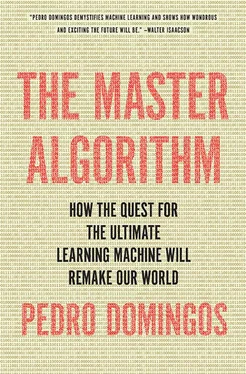In perception and memory, a chunk is just a symbol that stands for a pattern of other symbols, like AI stands for artificial intelligence. Newell and Rosenbloom adapted this notion to the theory of problem solving that Newell and Simon had developed earlier. Newell and Simon asked experimental subjects to solve problems-for example, derive one mathematical formula from another on the blackboard-while narrating aloud how they were going about it. They found that humans solve problems by decomposing them into subproblems, subsubproblems, and so on and systematically reducing the differences between the initial state (the first formula, say) and the goal state (the second formula). Doing so requires searching for a sequence of actions that will work, however, and that takes time. Newell and Rosenbloom’s hypothesis was that each time we solve a subproblem, we form a chunk that allows us to go directly from the state before we solve it to the state after. A chunk in this sense has two parts: the stimulus (a pattern you recognize in the external world or in your short-term memory) and the response (the sequence of actions you execute as a result). Once you’ve learned a chunk, you store it in long-term memory. Next time you have to solve the same subproblem, you can just apply the chunk, and save the time spent searching. This happens at all levels until you have a chunk for the whole problem and can solve it automatically. To tie your shoelaces, you tie the starting knot, make a loop with one end, wrap the other end around it, and pull it through the hole in the middle. Each of these is far from trivial for a five-year-old, but once you’ve acquired the corresponding chunks, you’re almost there.
Rosenbloom and Newell set their chunking program to work on a series of problems, measured the time it took in each trial, and lo and behold, out popped a series of power law curves. But that was only the beginning. Next they incorporated chunking into Soar, a general theory of cognition that Newell had been working on with John Laird, another one of his students. Instead of working only within a predefined hierarchy of goals, the Soar program could define and solve a new subproblem every time it hit a snag. Once it formed a new chunk, Soar generalized it to apply to similar problems, in a manner similar to inverse deduction. Chunking in Soar turned out to be a good model of lots of learning phenomena besides the power law of practice. It could even be applied to learning new knowledge by chunking data and analogies. This led Newell, Rosenbloom, and Laird to hypothesize that chunking is the only mechanism needed for learning-in other words, the Master Algorithm.
Being classic AI types, Newell, Simon, and their students and followers were strong believers in the primacy of problem solving. If the problem solver is powerful, the learner can piggyback on it and be simple. Indeed, learning is just another kind of problem solving. Newell and company made a concerted effort to reduce all learning to chunking and all cognition to Soar, but in the end they failed. One problem was that, as the problem solver learned more chunks, and more complicated ones, the cost of trying them often became so high that the program got slower instead of faster. Somehow humans avoid this, but so far researchers in this area have not figured out how. On top of that, trying to reduce reinforcement learning, supervised learning, and everything else to chunking ultimately created more problems than it solved. Eventually, the Soar researchers conceded defeat and incorporated those other types of learning into Soar as separate mechanisms. Nevertheless, chunking remains a preeminent example of a learning algorithm inspired by psychology, and the true Master Algorithm, whatever it turns out to be, must surely share its ability to improve with practice.
Chunking and reinforcement learning are not as widely used in business as supervised learning, clustering, or dimensionality reduction, but a simpler type of learning by interacting with the environment is: learning the effects of your actions (and acting accordingly). If the background color of your e-commerce site’s home page is currently blue and you’re wondering whether making it red would increase sales, try it out on a hundred thousand randomly chosen customers and compare the results with those of the regular site. This technique, called A/B testing, was at first used mainly in drug trials but has since spread to many fields where data can be gathered on demand, from marketing to foreign aid. It can also be generalized to try many combinations of changes at once, without losing track of which changes lead to which gains (or losses). Companies like Amazon and Google swear by it; you’ve probably participated in thousands of A/B tests without realizing it. A/B testing gives the lie to the oft-heard criticism that big data is only good for finding correlations, not causation. Philosophical fine points aside, learning causality is learning the effects of your actions, and anyone with a stream of data they can affect can do it-from a one-year-old splashing around in the bathtub to a president campaigning for reelection.
Learning to relate
If we endow Robby the robot with all the learning abilities we’ve seen so far in this book, he’ll be pretty smart but still a bit autistic. He’ll see the world as a bunch of separate objects, which he can identify, manipulate, and even make predictions about, but he won’t understand that the world is a web of interconnections. Robby the doctor would be very good at diagnosing someone with the flu based on his symptoms but unable to suspect that the patient has swine flu because he has been in contact with someone infected with it. Before Google, search engines decided whether a web page was relevant to your query by looking at its content-what else? Brin and Page’s insight was that the strongest sign a page is relevant is that relevant pages link to it. Similarly, if you want to predict whether a teenager is at risk of starting to smoke, by far the best thing you can do is check whether her close friends smoke. An enzyme’s shape is as inseparable from the shapes of the molecules it brings together as a lock is from its key. Predator and prey have deeply entwined properties, each evolved to defeat the other’s properties. In all of these cases, the best way to understand an entity-whether it’s a person, an animal, a web page, or a molecule-is to understand how it relates to other entities. This requires a new kind of learning that doesn’t treat the data as a random sample of unrelated objects but as a glimpse into a complex network. Nodes in the network interact; what you do to one affects the others and comes back to affect you. Relational learners, as they’re called, may not quite have social intelligence, but they’re the next best thing. In traditional statistical learning, every man is an island, entire of itself. In relational learning, every man is a piece of the continent, a part of the main. Humans are relational learners, wired to connect, and if we want Robby to grow into a perceptive, socially adept robot, we need to wire him to connect, too.
The first difficulty we face is that, when the data is all one big network, we no longer seem to have many examples to learn from, just one-and that’s not enough. Naïve Bayes learns that a fever is a symptom of the flu by counting the number of fever-stricken flu patients. If it could only see one patient, it would either conclude that flu always causes fever or that it never does, both of which are wrong. We would like to learn that the flu is contagious by looking at the pattern of infections in a social network-a clump of infected people here, a clump of uninfected ones there-but we only have one pattern to look at, even if it’s in a network of seven billion people, so it’s not clear how to generalize. The key is to notice that, embedded in that big network, we have many examples of pairs of people. If acquaintances are more likely to both have the flu than pairs of people who have never met, then being acquainted with a flu patient makes you more likely to be one as well. Unfortunately, however, we can’t just count how many pairs of acquaintances in the data both have the flu and turn those counts into probabilities. This is because a person has many acquaintances, and all the pairwise probabilities don’t add up to a coherent model that lets us, for example, compute how likely someone is to have the flu given which of their acquaintances do. We didn’t have this problem when the examples were all separate, and we wouldn’t have it in, say, a society of childless couples, each living on their own desert island. But that’s not the real world, and there wouldn’t be any epidemics in it, anyway.
Читать дальше












